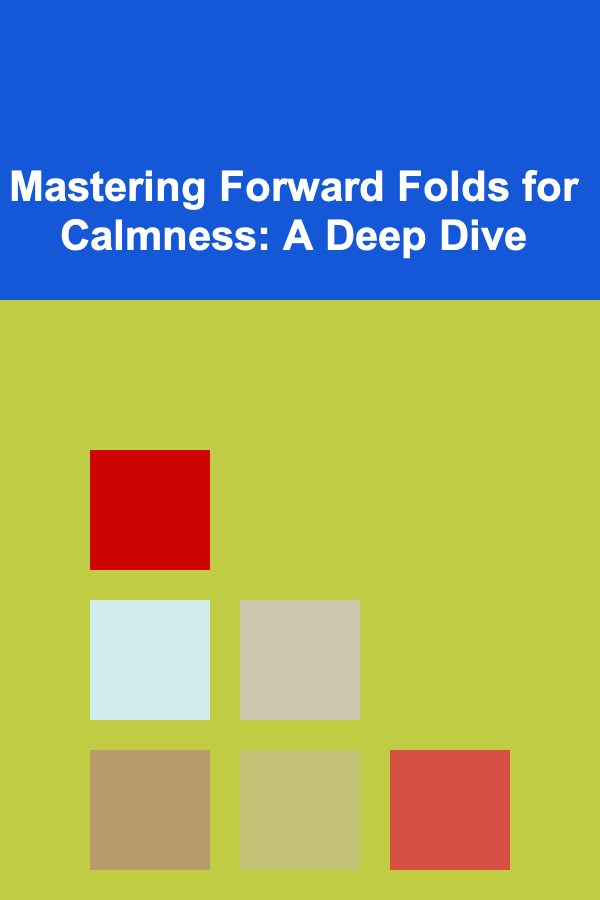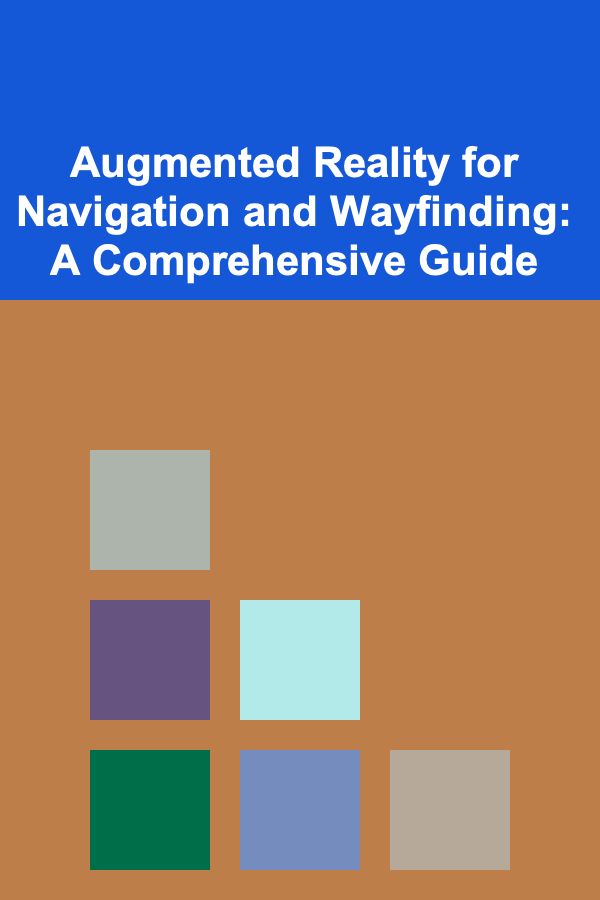
Mastering Forward Folds for Calmness: A Deep Dive
ebook include PDF & Audio bundle (Micro Guide)
$12.99$9.99
Limited Time Offer! Order within the next:

Introduction: More Than Just a Stretch
Forward folds, or forward bends (known as Uttanasana in Sanskrit for standing variations and variations like Paschimottanasana for seated ones), are foundational postures in various physical disciplines like yoga, Pilates, and general stretching routines. While seemingly simple, these poses offer a profound pathway to both physical and mental well-being. Often relegated to the role of a mere hamstring stretch, forward folds possess a powerful capacity to induce calmness, reduce stress, and promote a sense of groundedness. This article delves into the multifaceted benefits of forward folds, exploring their biomechanics, physiological effects, and psychological impact, ultimately providing a comprehensive guide to mastering these postures for optimal relaxation and overall well-being.
Beyond the physical benefits of increased flexibility and improved circulation, forward folds act as a gentle inversion, subtly shifting blood flow and calming the nervous system. They encourage introspection, fostering a sense of inner quietude and facilitating the release of tension held in the body and mind. This connection between the physical posture and the mental state is key to understanding the true potential of forward folds as tools for managing stress and cultivating inner peace.
The Biomechanics of Forward Folds: Understanding the Body's Response
To truly master forward folds, it's crucial to understand the underlying biomechanics. This involves recognizing which muscles are actively engaged, which are being stretched, and how the skeletal structure is aligned to support the pose safely and effectively.
Key Muscle Groups Involved:
- Hamstrings: The primary target of most forward folds, the hamstrings run down the back of the thighs and connect to the pelvis. Their flexibility is crucial for achieving a deeper and more comfortable fold.
- Gluteals: The glutes, particularly the gluteus maximus, play a supporting role in stabilizing the pelvis and facilitating the hip hinge movement.
- Spinal Erectors: While the intention is to relax the back in a forward fold, the spinal erectors work to maintain some degree of spinal stability, especially in variations where a flat back is desired.
- Calves (Gastrocnemius and Soleus): Tightness in the calf muscles can significantly limit the depth of a forward fold. Addressing calf flexibility is often necessary for progressing in these postures.
- Abdominals: The abdominal muscles, particularly the transverse abdominis, play a crucial role in engaging the core and supporting the spine, especially during the forward folding action. They help to protect the lower back.
The Importance of the Hip Hinge:
The hip hinge is a fundamental movement pattern essential for safe and effective forward folds. It involves bending at the hips while keeping the back as straight as possible, as opposed to rounding the spine. This allows for a deeper stretch in the hamstrings and minimizes the risk of lower back strain. Imagine sticking your tailbone out behind you as you hinge forward. Practicing the hip hinge with a neutral spine before attempting deeper folds is crucial for injury prevention.
Spinal Alignment: To Round or Not to Round?
The question of whether to round or keep the back flat in a forward fold is a common one. The answer depends on individual flexibility, the specific variation of the pose, and the overall goal. Generally:
- For beginners or those with tight hamstrings: A slight rounding of the spine is often acceptable and even encouraged initially. The priority is to avoid overstretching and causing discomfort in the lower back. Bent knees are essential here.
- As flexibility improves: Work towards maintaining a flatter back, hinging more from the hips. This will allow for a deeper stretch in the hamstrings and a more effective release of tension in the back muscles. However, never force a flat back; listen to your body.
- In certain variations: Such as those emphasizing relaxation and letting go, a gentle rounding of the spine can be beneficial for softening the back muscles and releasing tension in the neck and shoulders. Examples include Ragdoll pose.
Breathing and the Forward Fold:
Breath plays a pivotal role in forward folds. Inhaling often prepares the body, lengthening the spine. Exhaling helps to deepen the fold and release tension. Consciously focusing on the breath allows for a more mindful and effective practice. Avoid holding your breath. Deep, slow breaths help to calm the nervous system and facilitate a deeper stretch.
Physiological Effects: Calming the Nervous System
The calming effects of forward folds extend beyond the muscular and skeletal systems, impacting the nervous system and endocrine system in profound ways.
Stimulating the Parasympathetic Nervous System:
Forward folds gently stimulate the parasympathetic nervous system (PNS), often referred to as the "rest and digest" system. This is achieved through several mechanisms:
- Slowing the Heart Rate: The gentle inversion created by forward folds encourages blood flow back towards the heart, which can help to lower the heart rate.
- Lowering Blood Pressure: The relaxation induced by the pose can contribute to a decrease in blood pressure.
- Promoting Deep Breathing: The forward folding action can encourage deeper, more diaphragmatic breathing, which further activates the PNS.
Reducing Stress Hormones:
Chronic stress leads to elevated levels of cortisol, the primary stress hormone. Forward folds can help to modulate cortisol levels by:
- Reducing Adrenal Gland Activity: By promoting relaxation and stimulating the PNS, forward folds can help to reduce the activity of the adrenal glands, which are responsible for producing cortisol.
- Increasing GABA Levels: GABA (gamma-aminobutyric acid) is a neurotransmitter that has a calming effect on the brain. Some studies suggest that yoga practices, including forward folds, can increase GABA levels.
Improving Digestion:
The gentle compression of the abdominal organs in forward folds can stimulate digestion and promote healthy bowel movements. This can be particularly beneficial for those experiencing stress-related digestive issues.
Releasing Tension in the Back and Neck:
Forward folds can help to release tension in the muscles of the back and neck, which are common areas for storing stress. This can lead to a reduction in headaches, neck pain, and back pain.
Enhancing Circulation:
The inverted nature of many forward folds promotes increased blood flow to the brain, which can improve cognitive function and reduce mental fatigue. Improved circulation also benefits the muscles and tissues throughout the body.
Psychological Impact: Cultivating Inner Peace
Beyond the physical and physiological benefits, forward folds have a profound impact on our psychological state. They can help to cultivate inner peace, reduce anxiety, and promote a sense of groundedness.
Encouraging Introspection and Mindfulness:
The forward folding action naturally draws our attention inward, encouraging introspection and self-reflection. This can be a powerful tool for becoming more aware of our thoughts, feelings, and bodily sensations.
Releasing Emotional Tension:
The hips and hamstrings are often referred to as "emotional storage" areas in the body. Tightness in these areas can be a sign of suppressed emotions or unresolved trauma. Forward folds can help to release this emotional tension, allowing us to process and let go of difficult feelings.
Promoting a Sense of Groundedness:
Forward folds connect us to the earth, promoting a sense of groundedness and stability. This can be particularly helpful for those who feel anxious or scattered. The feeling of the feet firmly planted on the ground can provide a sense of security and support.
Reducing Anxiety and Fear:
The calming effects of forward folds on the nervous system can help to reduce anxiety and fear. By lowering heart rate and blood pressure, and by promoting relaxation, these poses can help to quiet the mind and ease feelings of unease.
Cultivating Self-Compassion:
It's important to approach forward folds with self-compassion, accepting your body's limitations and avoiding the temptation to push yourself too hard. This attitude of self-acceptance can extend beyond the mat and into other areas of your life.
Practical Guide to Mastering Forward Folds: Step-by-Step Instructions and Modifications
This section provides a step-by-step guide to several common forward fold variations, along with modifications to suit different levels of flexibility and experience. Remember to listen to your body and stop if you feel any pain.
Standing Forward Fold (Uttanasana):
- Start in Tadasana (Mountain Pose): Stand tall with your feet hip-width apart or slightly wider. Ground your feet firmly into the floor.
- Inhale: Reach your arms overhead, lengthening your spine.
- Exhale: Hinge forward from your hips, keeping your back as straight as possible. Avoid rounding your spine initially.
- Bend your knees: If necessary, bend your knees generously to protect your lower back and allow your chest to rest on your thighs.
- Release your head and neck: Let your head hang heavy, releasing any tension in your neck.
- Hands: Reach for the floor, your shins, or your ankles. If you can't reach the floor, that's perfectly fine. Focus on maintaining a gentle stretch in your hamstrings.
- Breathe deeply: Hold the pose for 5-10 breaths, focusing on lengthening your spine on the inhales and deepening the fold on the exhales.
- To come out: Engage your core and slowly roll up to standing, one vertebra at a time, with your head coming up last. Alternatively, place your hands on your shins, inhale to a flat back, and exhale to fold again before rolling up.
Modifications:
- Bent Knees: Bend your knees as much as you need to. This is especially important if you have tight hamstrings or lower back pain.
- Hands on Blocks: Place your hands on yoga blocks if you can't reach the floor.
- Ragdoll Variation: Grasp opposite elbows and allow your torso to hang heavy. Gently sway from side to side for a deeper release in the back.
Seated Forward Fold (Paschimottanasana):
- Start in Dandasana (Staff Pose): Sit with your legs extended straight out in front of you, feet flexed, and spine erect.
- Engage your core: Actively engage your abdominal muscles to support your spine.
- Inhale: Reach your arms overhead, lengthening your spine.
- Exhale: Hinge forward from your hips, reaching for your toes. If you can't reach your toes, grab your shins or ankles.
- Maintain a straight back: As much as possible, try to maintain a straight back, avoiding rounding your spine excessively.
- Bend your knees: It's perfectly acceptable to bend your knees in this pose, especially if you have tight hamstrings. The goal is to protect your lower back and allow your chest to move towards your thighs.
- Release your head and neck: Once you've reached your maximum point of forward fold, release your head and neck, allowing them to hang heavy.
- Breathe deeply: Hold the pose for 5-10 breaths, focusing on lengthening your spine on the inhales and deepening the fold on the exhales.
- To come out: Inhale and slowly sit back up, one vertebra at a time.
Modifications:
- Bent Knees: Bend your knees as much as you need to. Place a rolled-up blanket or towel under your knees for added support.
- Strap: Use a yoga strap around your feet to help you reach further.
- Elevated Seat: Sit on a folded blanket or cushion to elevate your hips, which can make it easier to hinge forward from the hips.
Wide-Legged Forward Fold (Prasarita Padottanasana):
- Start in Tadasana (Mountain Pose): Stand tall with your feet hip-width apart.
- Step your feet wide apart: Step your feet out to the sides, about 3-4 feet apart, depending on your height and flexibility. Ensure your feet are parallel, or slightly turned inward.
- Engage your core: Engage your abdominal muscles to support your spine.
- Inhale: Reach your arms overhead, lengthening your spine.
- Exhale: Hinge forward from your hips, keeping your back as straight as possible.
- Hands: Place your hands on the floor between your feet, or on yoga blocks if you can't reach the floor. You can also grab your ankles.
- Release your head and neck: Let your head hang heavy, releasing any tension in your neck. You can also rest the crown of your head on the floor if you are flexible enough.
- Breathe deeply: Hold the pose for 5-10 breaths, focusing on lengthening your spine on the inhales and deepening the fold on the exhales.
- To come out: Engage your core and slowly walk your hands back towards your feet. Inhale and slowly rise back up to standing, keeping your back straight. Step your feet back together.
Modifications:
- Hands on Blocks: Use yoga blocks to support your hands if you can't reach the floor.
- Bend your knees slightly: If you have tight hamstrings, bend your knees slightly to protect your lower back.
- Head on Block/Pillow: If the stretch is too intense on the neck, place a block or pillow underneath your head for support.
Integrating Forward Folds into Your Daily Routine
To reap the full benefits of forward folds for calmness, it's important to integrate them into your daily routine. Even a few minutes of forward folds each day can make a significant difference in your stress levels and overall well-being.
Morning Routine:
Include a few gentle forward folds in your morning routine to wake up your body and mind. Standing forward fold with bent knees and gentle sway can be a good way to start the day.
Mid-Day Break:
Take a short break during the day to practice a few forward folds. Seated forward fold at your desk or a quick wide-legged forward fold can help to relieve tension and improve focus.
Evening Wind-Down:
Forward folds are particularly beneficial in the evening to calm the nervous system and prepare for sleep. Holding seated forward fold for a longer duration with soft music can be a relaxing way to end the day.
Mindful Practice:
Remember to practice forward folds mindfully, paying attention to your breath and your body. Avoid pushing yourself too hard and focus on cultivating a sense of relaxation and ease. Consistency is key. Even 5 minutes a day is better than one long session once a week.
Cautions and Contraindications
While forward folds offer numerous benefits, it's important to be aware of certain cautions and contraindications.
- Lower Back Pain: If you have lower back pain, it's essential to practice forward folds with caution and modifications. Bend your knees generously and avoid rounding your spine excessively. Consult with a healthcare professional or experienced yoga teacher before practicing forward folds if you have any concerns.
- Sciatica: If you have sciatica, forward folds may aggravate your symptoms. Avoid deep forward folds and focus on gentle stretches.
- Herniated Disc: If you have a herniated disc, consult with a healthcare professional before practicing forward folds. Avoid rounding your spine and focus on maintaining a straight back.
- High Blood Pressure: If you have high blood pressure, practice forward folds with caution. Avoid holding your breath and come out of the pose slowly to prevent dizziness.
- Pregnancy: Pregnant women should modify forward folds to accommodate their growing bellies. Wide-legged forward folds and standing forward folds with bent knees are generally safe. Consult with a qualified prenatal yoga instructor for guidance.
- Glaucoma or Detached Retina: Avoid prolonged inversions if you have glaucoma or a detached retina. Short holds and modifications are crucial. Consult with your doctor before practicing.
Always listen to your body and stop if you feel any pain. It's always a good idea to consult with a healthcare professional or experienced yoga teacher before starting any new exercise program.
Conclusion: Embracing the Calming Power of Forward Folds
Forward folds are more than just stretches; they are powerful tools for cultivating calmness, reducing stress, and promoting overall well-being. By understanding the biomechanics, physiological effects, and psychological impact of these poses, and by practicing them mindfully with appropriate modifications, you can unlock their full potential. Embrace the journey of mastering forward folds, and you'll discover a path to greater flexibility, inner peace, and a more grounded sense of self. Remember that progress is not linear and that honoring your body's current abilities is the most important aspect of a sustainable and beneficial practice. Start slowly, be patient, and enjoy the journey towards a calmer and more balanced you.
Reading More From Our Other Websites
- [Home Renovating 101] How to Add a Second Story to Your Home Without a Major Overhaul
- [Ziplining Tip 101] How to Maintain Your Zipline Gear for Year‑Round Use
- [Personal Finance Management 101] How to Lay the Groundwork for Building a Strong Financial Foundation Before Marriage
- [Star Gazing Tip 101] How to Use a Simple Arduino Light Sensor to Measure Sky Darkness Levels Over Time
- [Organization Tip 101] How to Utilize Local Resources for Educational Activities
- [Home Staging 101] How to Use Accessories to Add Charm During Home Staging
- [Home Soundproofing 101] How to Build a DIY Soundproofing Solution for Your Home
- [Home Rental Property 101] How to Manage Your Time as a Busy Landlord
- [Organization Tip 101] How to Create a Simple System for Tracking Home Expenses
- [Trail Running Tip 101] How Weather, Altitude, and Terrain Affect Your Trail Running Hydration Needs

Affordable Beauty: Top Strategies for Saving Money on Beauty and Grooming Services
Read More
Becoming a Photographer: Essential Skills for Capturing Stunning Images
Read More
How to Implement a Daily Cleaning Routine for Your Office
Read More
How To Support Children's Transitions to School
Read More
Augmented Reality for Navigation and Wayfinding: A Comprehensive Guide
Read More
10 Tips for Managing Stress as a Radiologic Technologist
Read MoreOther Products

Affordable Beauty: Top Strategies for Saving Money on Beauty and Grooming Services
Read More
Becoming a Photographer: Essential Skills for Capturing Stunning Images
Read More
How to Implement a Daily Cleaning Routine for Your Office
Read More
How To Support Children's Transitions to School
Read More
Augmented Reality for Navigation and Wayfinding: A Comprehensive Guide
Read More